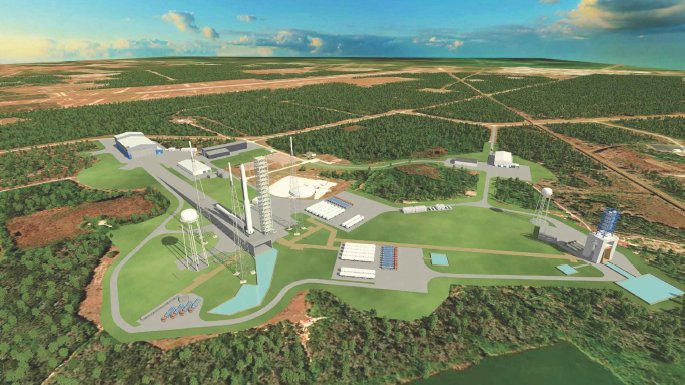Anbei ein Rendering vom zukünftigen Startkomplex am Cape, der die bestehenden Gelände LC-36 and LC-11 zu einem kombinierten zusammenfasst.
Irgendwelche Tipps was wir ganz rechts sehen? Vielleicht ein Teststand für Teilkomponenten? EDIT: Ist ein Teststand für einzelne Triebwerke, siehe unten.
Zudem scheint mir das Landepad abzugehen, mit SpaceX wird man sich LZ-1 wohl kaum teilen wollen. EDIT: Ganz vergessen, man landet ja auf der patentierten Ozeanplattform.

Quelle:
https://twitter.com/FLSPACErePORT/status/774040941510262784EDIT:
Ich habe noch einen detailierten Plan des Komplexes gefunden, der auch meine obige Frage beantwortet:

Quelle:
https://permitting.sjrwmd.com/epermitting/jsp/Search.do?theAction=searchDetail&permitNumber=147362- - -
Und noch ein interessantes Schriftstück. Beschäftigt sich eigentlich hauptsäschlich mit dem Entwässerungssystem, hat aber zu Beginn einen allgemeinen Teil:
1.1 PURPOSE AND DESCRIPTION
Blue Origin has an incremental approach in developing launch vehicles and is advancing to the orbital
human spaceflight phase. This phase is defined by the development of an Orbital Launch Vehicle (OLV) and
an accompanying Orbital Launch Site (OLS) to support human spaceflight, as well as satellite and science
payload launches. The OLV is a multi-stage launch system capable of carrying either the Blue Origin Space
Vehicle (SV) spacecraft with participants and/or crew, or carry the Payload Accommodations (PA) which
would be comprised of one or more Spacecraft (SC) in a Payload Fairing (PLF). The launch vehicle’s 1st Stage
and SV are reusable and designed to be flown numerous times. Present plans call for returning first stages
for a landing on a downrange ocean-going platform, and return it to a facility for reuse.
The manufacturing of the large elements (e.g. 1st Stage, 2nd Stage, PLF, etc.) is planned to occur at a new
facility located at Exploration Park (Phase 2) on Kennedy Space Center (KSC).
[snipped section about wastewater management]
Final integration of the various flight elements of the launch vehicle, as well as spaceflight participant preparations will occur at the OLS and is part of this project.
Blue Origin is planning to construct and operate an OLS at the combined areas of Launch Complex (LC)-11
and LC-36 at Cape Canaveral Air Force Station (CCAFS) in Brevard County, Florida (see Figure 1). The major
elements of the redevelopment at LC-11 and LC-36 include a Launch Pad, Integration Facility, Engine
Assembly and Control Building, Launch Vehicle Refurbishment Facility, Engine Test Stand, systems to
recover and refurbish reusable space systems (1st Stage and SV), new roadway corridors, updated utilities,
and a stormwater management system. The “built-out” design will result in a total of 43.84 acres of new
impervious surface (including buildings). After arrival at the Integration Facility, the 1st Stage and 2nd Stage,
and a possible 3rd Stage, would then be mated together and integrated onto the Transporter Erector
system. Following integration of the booster stages, the SV (or PA) would be attached, and then the entire
system would undergo a readiness test. The OLV would then be transported from the Integration Facility to
the Launch Pad and erected for launch. After a successful launch the first stage would return to the Earth
for recovery in the Atlantic Ocean approximately 750 nautical miles downrange in the Atlantic Ocean, east
of and well off the Carolina coast, and any payload or capsule would land under parachute at a yet to be
determined land site in Texas.
Die Landeplattform wird 750 nautische Meilen vom Startkomplex entfernt, vor der Küste South oder North Carolinas, liegen. Das ist in etwa doppelt so weit wie bei SpaceX Starts mit ASDS Landung. Spricht für mich dafür, dass man rein ballistisch ohne zusätzliche Zündungen außer zum gebremsten Atmosphäreneintritt landen könnte.
Aus einer Umweltbewertung:
The Proposed Action would be to construct and operate a commercial Orbital Launch Site (OLS) at the combined areas of LC-36 and LC-11 at CCAFS, Florida. The facility would contain infrastructure to test rocket engines, integrate launch vehicles, and conduct launches of liquid fueled, medium and heavy-lift class orbital launch vehicles (OLV). The action includes construction of a launch pad, engine test stand, integration facility, launch vehicle wash building, fuel storage tanks, as well as roads, lighting, a parking lot and multiple stormwater retention ponds throughout the complex. Operationally, the proposed action includes the potential for up to 12 launches per year of the OLV.
[...]
Engine firings will occur for acceptance testing only, and will not test multiple engines simultaneously.
- Bis zu 12 Starts pro Jahr
- Triebwerke werden nur einzeln getestet, anscheinend kein Hotfire-Test des gesamten Boosters
